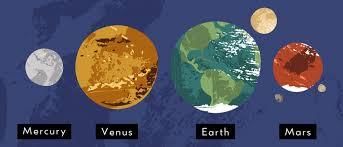Year 5 Exam > Year 5 Notes > Year 5 Science > What are the rocky planets?
What are the rocky planets? | Year 5 Science PDF Download
The Rocky Planets
- There are four planets in our solar system known as the rocky planets.
- These are: Mercury, Venus, Earth, and Mars.

Characteristics of the Rocky Planets
- Mercury: Mercury is the closest planet to the Sun and has extreme temperature variations. It has a very thin atmosphere.
- Venus: Venus is the hottest planet in our solar system due to its thick atmosphere, primarily composed of carbon dioxide.
- Earth: Earth is the only planet known to support life, with a diverse range of ecosystems and a protective atmosphere.
- Mars: Mars is often called the "Red Planet" due to its reddish appearance. It has polar ice caps and evidence of ancient water sources.
Rocky planet facts
- Rocks and metals make up the composition of rocky planets.
- They possess a solid surface along with a core primarily composed of iron.
- These planets, which include Mercury, Venus, Earth, and Mars, are the four closest to the Sun.
- Rocky planets revolve around the Sun in their respective orbits, defined as the path an object follows around a specific point in space.
- Compared to gas planets, rocky planets are smaller in size and rotate at a slower pace.
Question for What are the rocky planets?Try yourself: Which planet in our solar system is known as the "Red Planet"?View Solution
The document What are the rocky planets? | Year 5 Science is a part of the Year 5 Course Year 5 Science.
All you need of Year 5 at this link: Year 5
|
19 videos|22 docs|6 tests
|
FAQs on What are the rocky planets? - Year 5 Science
| 1. What are rocky planets? |  |
Ans. Rocky planets, also known as terrestrial planets, are planets that are primarily composed of silicate rocks or metals. These planets have a solid surface and include planets like Earth, Mars, Venus, and Mercury.
| 2. How do rocky planets differ from gas giants? |  |
Ans. Rocky planets have a solid surface made up of rocks and metals, while gas giants are primarily composed of hydrogen and helium gases with no solid surface. Gas giants like Jupiter and Saturn are much larger in size compared to rocky planets.
| 3. What are some characteristics of rocky planets? |  |
Ans. Rocky planets tend to have higher densities compared to gas giants due to their solid composition. They also have thinner atmospheres and are closer to their parent stars, making them warmer than gas giants.
| 4. Are rocky planets more likely to support life? |  |
Ans. Rocky planets are considered more likely to support life compared to gas giants due to their solid surfaces and potential for liquid water to exist. Earth, a rocky planet, is the only known planet to support life in the solar system.
| 5. How do rocky planets form? |  |
Ans. Rocky planets are believed to form from the accumulation of solid particles in the protoplanetary disk around a young star. These particles clump together over time to form larger rocky bodies that eventually become rocky planets.
Related Searches















